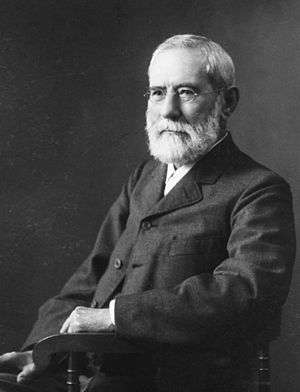Oswald Schmiedeberg

Oswald Schmiedeberg (10 October 1838 – 12 July 1921) was a Baltic German pharmacologist. He is sometimes referred to as the "Father of Modern Pharmacology."
Schmiedeberg was born at Gut Laidsen (now Laidze parish, Talsi municipality, Latvia) in the Imperial Russian province of Courland. His parents were Wilhelm Schmiedeberg, born 1809 in Windau, Courland, died 1878 in Dorpat, and his wife Lucie Bernard, born 1813 in Lausanne, Switzerland, died 1871. He was the eldest of six siblings. In 1866 he earned his medical doctorate from the University of Dorpat with a thesis concerning the measurement of chloroform in blood.[1] Afterwards he was an assistant to Rudolf Buchheim (1820–1879) at Dorpat (Tartu). In 1872 he became a professor of pharmacology at the University of Strasbourg, where he remained for the next 46 years.
His work largely dealt with finding the correlation between the chemical structure of substances and their effectiveness as pharmaceuticals. With his pupil Hans Horst Meyer he discovered glucuronic acid as a conjugation partner in xenobiotic metabolism and later found that glucuronic acid was also a component of cartilage and occurred as a disaccharide of chondroitin sulfate. He studied the composition of hyaluronic acid and explored its relationship to collagen, amyloid and chondroitin sulfate. In 1869 he demonstrated that muscarine had a similar effect on the heart as electrical stimulation of the vagus nerve. He also demonstrated the hypnotic properties of urethane.
Schmiedeberg was a major factor in the success of the German pharmaceutical industry prior to World War II, having trained most of the professors at the time.[1] He published over 200 scientific books and articles. With pathologists Bernhard Naunyn (1839–1925) and Edwin Klebs (1834–1913), he was founder of the influential Archiv für experimentelle Pathologie und Pharmakologie. He died in Baden-Baden.
Publications
- Ueber die quantitative bestimmung des Chloroforms im Blute und sein Verhalten gegen dasselbe, 1866 – On the quantitative determination of chloroform in the blood, etc.
- Das Muscarin. Das giftige Alkaloid des Fliegenpilzes (Agaricus muscarius L.) seine Darstellung, chemischen Eigenschaften, physiologischen Wirkungen, toxicologische Bedeutung und sein Verhältniss zur Pilzvergiftung im allgemeine, 1869 – Muscarine. The poisonous alkaloid of fly agaric mushroom, its representation, chemical properties, physiological effects, etc.
- Grundriss der Arzneimittellehre, 1883 – Fundamentals of pharmacology.
- "The dietetic and therapeutic uses of ferratin"; published in English (1893).
- "Ferratin : the ferruginous element of food"; published in English (1894).
- Grundriss der Pharmakologie in Bezug auf Arzneimittellehre und Toxikologie, 1902 Digital 5th edition from 1906 by the University and State Library Düsseldorf
- Arzneimittel und genussmittel, 1912 – treatise on stimulants.[2] Digital edition by the University and State Library Düsseldorf
- Über die Pharmaka in der Ilias und Odyssee, 1918 Digital edition by the University and State Library Düsseldorf
References
- 1 2 "A brief history of pharmacology". Modern Drug Discovery, American Chemical Society. 2001. Retrieved 2 April 2007.
- ↑ WorldCat Identities (publications)
External links
| Wikimedia Commons has media related to Oswald Schmiedeberg. |
- Meyer, Hans H. (1922). "Oswald Schmiedeberg". Die Naturwissenschaften. 10 (5): 105–107. doi:10.1007/BF01488534.
- Kochweser, J; Schechter, P (1978). "Schmiedeberg in Strassburg 1872–1918: The making of modern pharmacology". Life Sciences. 22 (13–15): 1361–1371. doi:10.1016/0024-3205(78)90099-1. PMID 351320.
- Muscholl, E (2001). "Schmiedeberg, Oswald". doi:10.1038/npg.els.0003617.
- Bäumer Beatrix (2007), "Schmiedeberg, Johann Ernst Oswald", Neue Deutsche Biographie (NDB) (in German), 23, Berlin: Duncker & Humblot, pp. 227–228